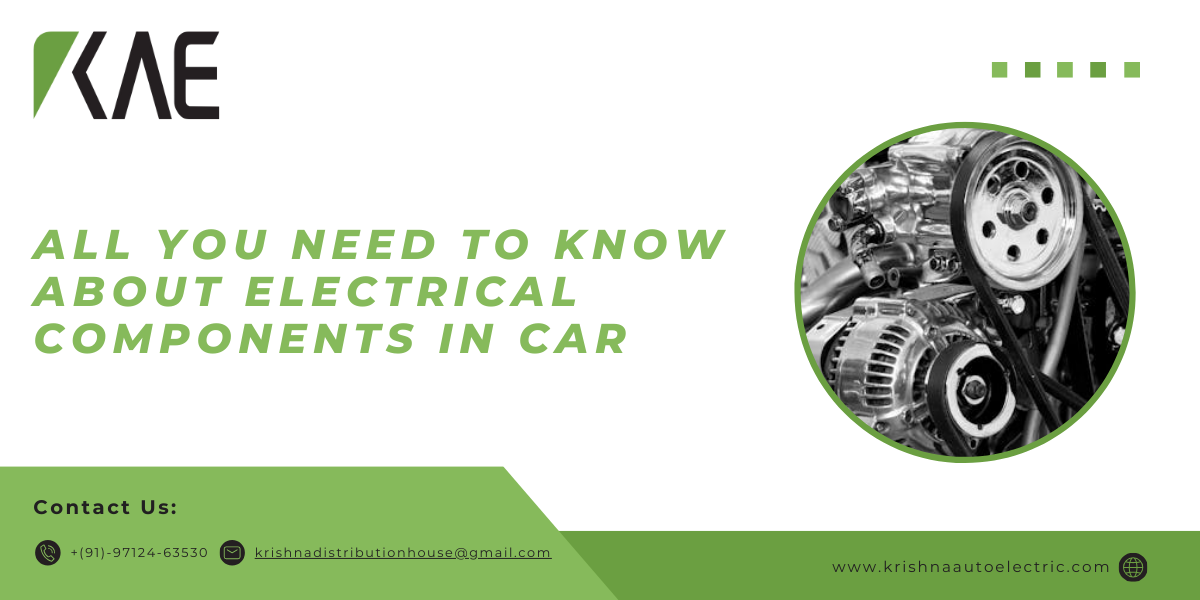In today’s automotive world, car electrical parts are at the heart of every function your vehicle performs. From starting the engine to powering entertainment systems, automotive electrical components ensure both performance and comfort. Modern vehicles come equipped with a wide variety of car electronics parts, from essential engine electrical parts like the alternator and starter to comfort-enhancing electrical accessories in cars such as power windows, infotainment systems, and advanced safety features.
Understanding your car electrical system is not just for mechanics; even drivers benefit from knowing how these components work, as it can help in maintaining the vehicle, preventing breakdowns, and saving on costly repairs.
The Evolution of Car Electrical Components
Gone were the days when cars and other vehicles had no electrical components. Headlights and backlights were powered by gas, the driver had to use the crank to start the engine, and a bell replaced the horn. However, by 1920 almost all car companies had introduced a battery-run electrical starter.
Over the decades, automotive electrical technology has advanced rapidly, transforming the way vehicles operate. A car’s electrical system today can be divided into three main subsystems:
- Starting System: Uses the battery and starter motor to bring the engine to life.
- Charging System: Powered by the alternator to keep the battery charged and supply electricity to all running components.
- Accessory System: Runs automotive electronic components like air-conditioning, infotainment, and safety features.
Together, these subsystems ensure that your vehicle functions reliably and efficiently.
Major Car Electrical Components and Their Functions
1. Alternator
In the early days of modern cars, gas was used to charge the battery, while today an alternator or dynamo has taken its place. The alternator is connected to the engine through a gear, and when the engine runs, the alternator draws power from the engine, which in turn generates electricity. Electricity keeps the battery charged and also fulfills the requirements of all the electrical components.
2. Battery
The battery is the most essential electric vehicle part. It transmits power to a self-starter to start the engine of a car. Besides, starting the engine of a car, the battery can also be used in place of the generator. For example, you can play the audio system in your car when the engine is off, and at the same time, it supplies power to the headlights and air-conditioning too. In fact, it is the backbone of the electrical system in a vehicle.
3. Starter
It serves only one but very significant purpose, and that is to start your vehicle. The battery-powered starter rotates the flywheel, helping the crankshaft to run at the required speed to keep the engine running. The starter receives a punch of electric energy in a second therefore, it is advised to keep headlights and audio system off before using the starter. It will ensure its long life.
4. Fuel Pump Switch
A petrol engine needs sparks to fire, and the ignition coil helps to burn the fuel, while a diesel engine needs the pump to remain on to keep injecting fuel so that the engine will continue to run.
5. Cooling Fans
In the traditional model of cars, cooling fans (also known as radiator fans) were connected to the engine. However, with the advancement of technology in the car, mainly after the 4WD advancement, the cooling fans are connected to the battery so that they can run even when the engine of the car is off.
6. Air Conditioner Blower
There are fans in the passage of the switch knob which are electric-powered. The fans circulate the air into the car cabin.
7. Lighting System
The entire lighting system in the car is electrified. They are battery-powered so that they can be kept on even when the car is not running or off. In the traditional model, the gas was used for lights.
8. Motors
There are some of the motors in the car that are both electric and battery-powered. The wiper ensures safe driving by wiping the rainwater from the front glass, while the window glass can also be operated through the switch. Besides, the side glasses in most of the cars are also adjusted through a switch that is both battery and electric-powered.
Complete Car Electrical Components List
Modern vehicles feature an extensive range of car electrical parts that work together for safety, performance, and comfort. Some common components include:
- Battery
- Alternator
- Starter motor
- Fuse box and relays
- Wiring harness
- Ignition coil
- Engine Control Unit (ECU)
- Cooling fans
- Wiper motor
- Headlights, taillights, and interior lights
- Air conditioner blower
- Power window motors
- Parking sensors & reverse cameras
Electrical Accessories in Cars
Beyond the essentials, vehicles are now equipped with automotive electronic parts that enhance comfort, convenience, and driving experience. Examples include:
- GPS navigation systems
- Touchscreen infotainment units
- Heated seats
- Automatic climate control
- Ambient lighting
- Bluetooth connectivity
- Advanced Driver Assistance Systems (ADAS)
These car electronics not only make driving more enjoyable but also improve safety and efficiency.
Other Important Automotive Electrical Components
Similarly, there are many other automotive electrical components that hold a significant place in automobile systems, including the on-board computer, combination switch, peripherals, signal transmission systems, and wiring. These are crucial parts, and when any of them fails, it is essential to have them checked by a professional mechanic immediately to avoid costly damage.
Common Electrical Problems and Maintenance Tips
Even the most advanced car electrical parts can develop issues over time due to wear, environmental factors, or lack of maintenance. Being aware of the early signs of trouble and following basic upkeep practices can help you avoid costly repairs and unexpected breakdowns.
Signs of Electrical Issues
- Dimming headlights or interior lights: If your headlights or cabin lights appear unusually dim or flicker while driving, it could indicate a weak battery, a failing alternator, or issues within the wiring system. Since lighting is a key part of the car electrical system, ignoring such signs can compromise safety, especially during night driving.
- Difficulty starting the engine: A slow crank or repeated clicking sounds when turning the key are often linked to a weak battery, corroded battery terminals, or a failing starter motor. The engine electrical parts, particularly the battery and starter, should be checked immediately to prevent getting stranded.
- Dashboard warning lights: Modern vehicles are equipped with sensors connected to various automotive electronic components. If the battery, alternator, or check engine light appears, it’s a direct signal that the car’s electrical health needs attention.
- Malfunctioning windows or accessories: Power windows, wipers, and infotainment systems rely on several car electronics parts. Slow window movement, erratic wipers, or non-functional accessories could be caused by a faulty switch, damaged motor, or blown fuse.
Maintenance Tips for Car Electrical Components
- Regularly check and clean battery terminals: Corrosion buildup on battery terminals can interrupt power flow to the car electrical components. Cleaning them with a baking soda solution and applying petroleum jelly can prevent oxidation.
- Inspect wiring for wear or corrosion: Exposed or frayed wires in the automotive electrical parts network can cause short circuits or even fires. Routine visual inspections, especially after long trips, help identify problems early.
- Replace blown fuses with the correct rating: Using an incorrect fuse size for your car electronics parts can lead to damage or safety hazards. Always follow the manufacturer’s recommendations for fuse ratings.
- Ensure alternator belts are in good condition: A loose or worn alternator belt can prevent the alternator from charging the battery effectively, affecting multiple electrical accessories in the car. Replacing belts on time maintains optimal performance.
Pro Tip: Proper care of your engine electrical parts, battery, alternator, and other automotive electronic components not only extends their lifespan but also keeps the entire car electrical system running smoothly. Preventive maintenance can save you from sudden roadside breakdowns and expensive repairs.
Conclusion
From essential car electrical components like the alternator, starter, and battery to convenience-focused electrical accessories in cars such as infotainment systems and advanced lighting, every part plays a vital role in your vehicle’s performance, safety, and comfort. Choosing high-quality, genuine automotive electrical components from reputable suppliers is the best way to guarantee reliability and long-term value. Whether you’re replacing a single car electronics part or upgrading your entire car electrical system, investing in the right parts will keep your vehicle running smoothly for years to come.
Upgrade Your Vehicle’s Performance with Genuine Car Electrical Parts
Your vehicle’s performance, safety, and comfort depend heavily on the quality of its car electrical parts. From the battery and alternator to starters, motors, and advanced engine electrical parts, every component plays a critical role in keeping your car running smoothly. Don’t compromise on reliability by using low-quality replacements or ignoring maintenance.
Ensure your car operates at its best by choosing genuine, high-quality automotive electrical parts designed to meet or exceed OEM standards. Whether you need a new battery, a replacement starter, or a complete overhaul of your car electrical system, Krishna Auto Electric provides durable and efficient solutions that save time, prevent breakdowns, and enhance performance.
Take control of your vehicle’s longevity today. Explore our full range of premium car electrical components and give your car the care it deserves. Your next smooth, worry-free drive starts here. Call us at +(91)-97124-63530 or +(91)-97123-63530 for any information.

